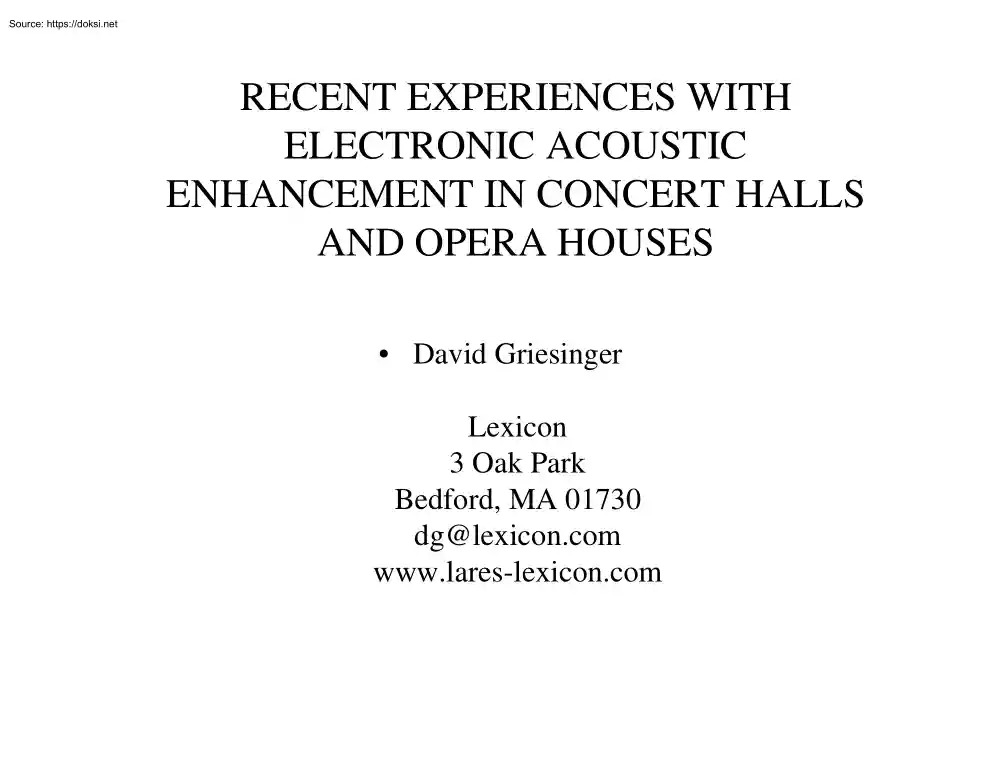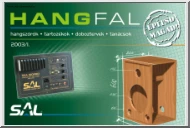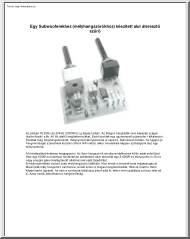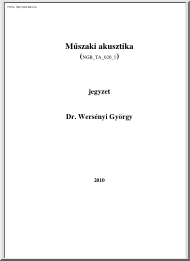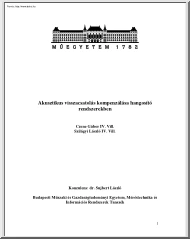Datasheet
Year, pagecount:1999, 32 page(s)
Language:English
Downloads:2
Uploaded:July 27, 2023
Size:1 MB
Institution:
-
Comments:
Attachment:-
Download in PDF:Please log in!
Comments
No comments yet. You can be the first!
Most popular documents in this category
Content extract
RECENT EXPERIENCES WITH ELECTRONIC ACOUSTIC ENHANCEMENT IN CONCERT HALLS AND OPERA HOUSES • David Griesinger Lexicon 3 Oak Park Bedford, MA 01730 dg@lexicon.com www.lares-lexiconcom Contents: • Major Message: There is real science in the design and installation of electronic enhancement systems. • 1. A few auditory perceptions – Intelligibility, Localization, Blend, Envelopment • 2. Overview of Acoustic Enhancement – Acoustic Feedback explained – Time Variant Systems • 3. Current installations – – – – Berlin - Staatsoper Toronto - Hummingbird Center Indianapolis - Circle Theater Adelade - Festival Center Theater Acoustic Perceptions: Intelligibility 1250Hz 1/3 octave filtered speech - Note the phones typically have a rapid rise, with gaps of 150ms or more. We localize the rising edges, and hear envelopment during the gaps. Intelligibility • When there is noise or reverberation speech comprehension is limited by the ability to separate sound
events (syllables) from each other. • reflected energy in the 50-150ms range disturbs this separation process maximally. • we want to minimize reflections in this time range! • Frequencies above 700Hz are of primary importance to speech (and music) intelligibility. Localization • Rising edges of acoustic events are preferentially detected and localized. • Speech phones and notes from soloists often rise in < 10ms. • Thus speech and soloists are easily localized. • Legato strings are often broadened. • ASW - Apparent Source Width - depends strongly on the rise time of the source! Envelopment • is primarily derived from the spatial properties of the background sound between notes. • Thus envelopment depends on the neural process that separates foreground and background. • Determining the end of a sound event often takes >100ms. • Reflected energy 150ms or more after the end of a sound event contributes to envelopment. • Envelopment depends on the
absolute level of the reflected sound. • Frequencies below 500Hz are particularly important. Separation of Envelopment from continuous spatial impression Perception of envelopment depends on detecting the ends of notes Early Spatial Impression - (Blend) • Lateral reflected energy in the 10ms to 50ms range reduces the “closeness” of the sound image • While this perception is pleasant, it is not musically essential. • too much energy in this time range can cause image broadening, timbre coloration, etc. • The ideal is to have the total energy in this time range two to four times less than the direct sound. Acoustics of Large Spaces Note the low level of reflections in the 50-150ms range, and the substantial energy in the later reverberant decay. This hall will combine clarity and envelopment. Acoustics of Small spaces Note the high level of early reflections, and the early onset of reverberant decay. The high energy in the 50-150ms time results in poor
intelligibility and coloration. Electronic Enhancement in small spaces • works best when the strong early reflections are controlled with adequate absorption. • electronics are used to supply later reverberation at the proper level. • The result is clear, uncolored direct sound, supported and augmented by envelopment. Electronic Acoustic Enhancement • Electronics allows us to separately manipulate reflected energy in different time ranges • But ONLY if the microphones are close to the source! • Acoustic feedback is the dominant feature in enhancement systems. • The amount of feedback is determined by the ratio of the source-microphone distance to the enhanced critical distance (hall radius)! • In a single channel system feedback must be below -20dB or there will be audible coloration. • This means for a 3 meter critical distance the microphones must be within .3m meters of the source! Coloration • Acoustic feedback is not frequency linear! • The
transfer function between loudspeaker and microphone is uneven, with peaks and dips. • Overall peaks and dips can be equalized flat with an analyzer such as JBL Smaart and a parametric equalizer. This must be done as a first step. • Once overall equalization is flat, there remains a fine structure of peaks and dips that is inherent in natural reverberation, and depends on the reverberation time. • Feedback will occur at the peaks of this fine structure, and will occur at system gains far below an average loop gain of zero dB. Fine structure of the transfer function • The height and width of the peaks depend on the combined natural and enhanced reverberation times. • The peak height and frequency vary chaotically with small changes in temperature, occupancy, etc. • These peaks lengthen the RT of selected frequencies and are HIGHLY AUDIBLE. • Coloration is reduced by using multiple microphones, speakers, and amplifiers - but only if the microphones and speakers are
separated by the critical distance. (MCR) • In an MCR system the Loop gain (feedback) is reduced by the sqrt of the # of channels. • An MCR system with 16 channels requires a microphone distance of 1.2 meters or less (Much better than 3m, but not very useful!) Transfer function from the stage of Boston Symphony Hall to row N. Note the ~12dB peak to average ratio Feedback around this path will increase the RT at the peak frequencies. Fine scale frequency response in Boston Symphony Amplitude in dB Note the ~2Hz peak width. This width is approximately 4/RT. We can use phase modulation to broaden this peak and lower its amplitude. Peak to average ratio • can be reduced through phase modulation • as much as 6dB of peak reduction can be achieved Phase modulation and pitch-shift • Phase modulation is associated with pitch-change. • Not all methods that produce phase modulation are the same. • There are methods that produce adequate phase modulation over a wide
frequency range, with minimal pitch shift. • With care a 6dB increase in stability can be achieved. • This 6dB gives an enormous improvement in coloration! • In our experience phase modulation is essential for producing low coloration even in a 16 channel system. Multiple Time Variant Reverberators - MTVR • allows a small number of microphones and a large number of loudspeakers. • Up to 18dB of feedback reduction can be achieved with two Lares frames - (each with 8 independent reverberators.) • source-microphone distance (cardioid) = • 2*.17*sqrt(#reverbs)/critical distance ~= 10meters! – The factor of 2 is the 6dB gain from phase modulation – The factor .17 is the cardioid directivity factor reduced by the 20dB necessary for low coloration. Assume 16 channels • When phase modulation is NOT used: ~=5meters! • With MTVR envelopment can be dramatically increased without artificial coloration. (but you need all the tricks) - Berlin - Deutches Staatsoper
Deutches Staatsoper - Berlin • • • • 0.9 seconds reverberation time small, highly damped stage house 4 audience rings high intelligibility, intimate seating - excellent dramatic connection between actor and audience. • low reverberance, poor envelopment. Orchestra sounds small, confined to the pit. Singers get no hall return • OK for Mozart, poor for Wagner • Similar to Zurich, London, Vienna, etc. Lares system • • • • • installed by the house Tonmeister, Albrecht Krieger 8 speakers in the ceiling were added 2 subwoofers on either side of the dome 40 speakers in the ring system frequency dependent equalization - 6dB more level below 300Hz. • 1.7 seconds RT below 500Hz for opera High envelopment, excellent hall return. Wagner lives! • 2.0 seconds RT broadband for Ballet • System in continuous use for more than two years, with excellent reviews. Toronto - Hummingbird Center Hummingbird Center - Toronto • large hall with 3200 seats, 1.2
seconds RT • Lares system has 4 Lares frames, 312 loudspeakers, 4-6 B&K microphones. • Direct sound is augmented in the front, under the balconies and in the back of the hall. • Reverberant level and decay time are adjustable above and below the balconies. • Similar equalization as the Staatsoper for opera. Indianapolis - Circle Theater Circle Theater, Indianapolis • Former Vaudeville house, now the Indianapolis Symphony Hall • System installed with Paul Scarborough of Jaffe, Holden, Scarborough. • Lares system (three frames) augments both the late reverberation and early lateral reflections. • Early reflection augmentation increases “Blend”. • Later reverberation increases warmth, envelopment. • Reviews have been very good. Adelade - Festival Center Theater Adelade Festival Center Theater • 2200 seats, 1.2 seconds RT System design by Steve Barbar of Lares Associates. • 350 sq meters absorption added to stage house, 250 sq meters to
stalls, carpets removed from the floors. • after treatment intelligibility was good • five Lares frames, 244 loudspeakers • System has high flexibility, excellent results for all types of musical performance. Vienna State Opera - Mörebisch San Diego - Copley Symphony Hall Conclusions • Multiple time variant reverberation makes electronic acoustic enhancement “undetectable”. • Successful systems often must add absorption to improve intelligibility - particularly in the stage house • Systems should be individually designed and carefully adjusted to achieve maximum musical benefit. • With MTVR and frequency equalization it is possible to achieve high envelopment at the same time as high clarity and intelligibility, even in small halls
events (syllables) from each other. • reflected energy in the 50-150ms range disturbs this separation process maximally. • we want to minimize reflections in this time range! • Frequencies above 700Hz are of primary importance to speech (and music) intelligibility. Localization • Rising edges of acoustic events are preferentially detected and localized. • Speech phones and notes from soloists often rise in < 10ms. • Thus speech and soloists are easily localized. • Legato strings are often broadened. • ASW - Apparent Source Width - depends strongly on the rise time of the source! Envelopment • is primarily derived from the spatial properties of the background sound between notes. • Thus envelopment depends on the neural process that separates foreground and background. • Determining the end of a sound event often takes >100ms. • Reflected energy 150ms or more after the end of a sound event contributes to envelopment. • Envelopment depends on the
absolute level of the reflected sound. • Frequencies below 500Hz are particularly important. Separation of Envelopment from continuous spatial impression Perception of envelopment depends on detecting the ends of notes Early Spatial Impression - (Blend) • Lateral reflected energy in the 10ms to 50ms range reduces the “closeness” of the sound image • While this perception is pleasant, it is not musically essential. • too much energy in this time range can cause image broadening, timbre coloration, etc. • The ideal is to have the total energy in this time range two to four times less than the direct sound. Acoustics of Large Spaces Note the low level of reflections in the 50-150ms range, and the substantial energy in the later reverberant decay. This hall will combine clarity and envelopment. Acoustics of Small spaces Note the high level of early reflections, and the early onset of reverberant decay. The high energy in the 50-150ms time results in poor
intelligibility and coloration. Electronic Enhancement in small spaces • works best when the strong early reflections are controlled with adequate absorption. • electronics are used to supply later reverberation at the proper level. • The result is clear, uncolored direct sound, supported and augmented by envelopment. Electronic Acoustic Enhancement • Electronics allows us to separately manipulate reflected energy in different time ranges • But ONLY if the microphones are close to the source! • Acoustic feedback is the dominant feature in enhancement systems. • The amount of feedback is determined by the ratio of the source-microphone distance to the enhanced critical distance (hall radius)! • In a single channel system feedback must be below -20dB or there will be audible coloration. • This means for a 3 meter critical distance the microphones must be within .3m meters of the source! Coloration • Acoustic feedback is not frequency linear! • The
transfer function between loudspeaker and microphone is uneven, with peaks and dips. • Overall peaks and dips can be equalized flat with an analyzer such as JBL Smaart and a parametric equalizer. This must be done as a first step. • Once overall equalization is flat, there remains a fine structure of peaks and dips that is inherent in natural reverberation, and depends on the reverberation time. • Feedback will occur at the peaks of this fine structure, and will occur at system gains far below an average loop gain of zero dB. Fine structure of the transfer function • The height and width of the peaks depend on the combined natural and enhanced reverberation times. • The peak height and frequency vary chaotically with small changes in temperature, occupancy, etc. • These peaks lengthen the RT of selected frequencies and are HIGHLY AUDIBLE. • Coloration is reduced by using multiple microphones, speakers, and amplifiers - but only if the microphones and speakers are
separated by the critical distance. (MCR) • In an MCR system the Loop gain (feedback) is reduced by the sqrt of the # of channels. • An MCR system with 16 channels requires a microphone distance of 1.2 meters or less (Much better than 3m, but not very useful!) Transfer function from the stage of Boston Symphony Hall to row N. Note the ~12dB peak to average ratio Feedback around this path will increase the RT at the peak frequencies. Fine scale frequency response in Boston Symphony Amplitude in dB Note the ~2Hz peak width. This width is approximately 4/RT. We can use phase modulation to broaden this peak and lower its amplitude. Peak to average ratio • can be reduced through phase modulation • as much as 6dB of peak reduction can be achieved Phase modulation and pitch-shift • Phase modulation is associated with pitch-change. • Not all methods that produce phase modulation are the same. • There are methods that produce adequate phase modulation over a wide
frequency range, with minimal pitch shift. • With care a 6dB increase in stability can be achieved. • This 6dB gives an enormous improvement in coloration! • In our experience phase modulation is essential for producing low coloration even in a 16 channel system. Multiple Time Variant Reverberators - MTVR • allows a small number of microphones and a large number of loudspeakers. • Up to 18dB of feedback reduction can be achieved with two Lares frames - (each with 8 independent reverberators.) • source-microphone distance (cardioid) = • 2*.17*sqrt(#reverbs)/critical distance ~= 10meters! – The factor of 2 is the 6dB gain from phase modulation – The factor .17 is the cardioid directivity factor reduced by the 20dB necessary for low coloration. Assume 16 channels • When phase modulation is NOT used: ~=5meters! • With MTVR envelopment can be dramatically increased without artificial coloration. (but you need all the tricks) - Berlin - Deutches Staatsoper
Deutches Staatsoper - Berlin • • • • 0.9 seconds reverberation time small, highly damped stage house 4 audience rings high intelligibility, intimate seating - excellent dramatic connection between actor and audience. • low reverberance, poor envelopment. Orchestra sounds small, confined to the pit. Singers get no hall return • OK for Mozart, poor for Wagner • Similar to Zurich, London, Vienna, etc. Lares system • • • • • installed by the house Tonmeister, Albrecht Krieger 8 speakers in the ceiling were added 2 subwoofers on either side of the dome 40 speakers in the ring system frequency dependent equalization - 6dB more level below 300Hz. • 1.7 seconds RT below 500Hz for opera High envelopment, excellent hall return. Wagner lives! • 2.0 seconds RT broadband for Ballet • System in continuous use for more than two years, with excellent reviews. Toronto - Hummingbird Center Hummingbird Center - Toronto • large hall with 3200 seats, 1.2
seconds RT • Lares system has 4 Lares frames, 312 loudspeakers, 4-6 B&K microphones. • Direct sound is augmented in the front, under the balconies and in the back of the hall. • Reverberant level and decay time are adjustable above and below the balconies. • Similar equalization as the Staatsoper for opera. Indianapolis - Circle Theater Circle Theater, Indianapolis • Former Vaudeville house, now the Indianapolis Symphony Hall • System installed with Paul Scarborough of Jaffe, Holden, Scarborough. • Lares system (three frames) augments both the late reverberation and early lateral reflections. • Early reflection augmentation increases “Blend”. • Later reverberation increases warmth, envelopment. • Reviews have been very good. Adelade - Festival Center Theater Adelade Festival Center Theater • 2200 seats, 1.2 seconds RT System design by Steve Barbar of Lares Associates. • 350 sq meters absorption added to stage house, 250 sq meters to
stalls, carpets removed from the floors. • after treatment intelligibility was good • five Lares frames, 244 loudspeakers • System has high flexibility, excellent results for all types of musical performance. Vienna State Opera - Mörebisch San Diego - Copley Symphony Hall Conclusions • Multiple time variant reverberation makes electronic acoustic enhancement “undetectable”. • Successful systems often must add absorption to improve intelligibility - particularly in the stage house • Systems should be individually designed and carefully adjusted to achieve maximum musical benefit. • With MTVR and frequency equalization it is possible to achieve high envelopment at the same time as high clarity and intelligibility, even in small halls
